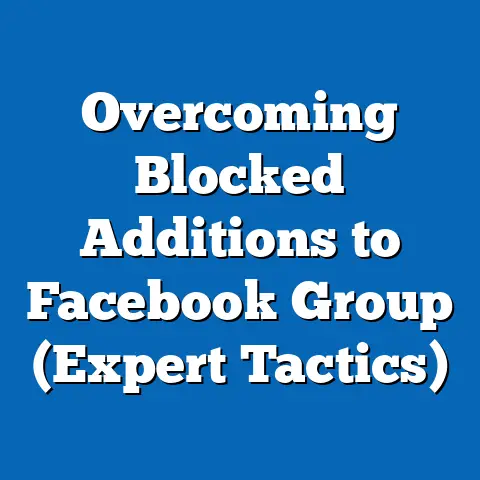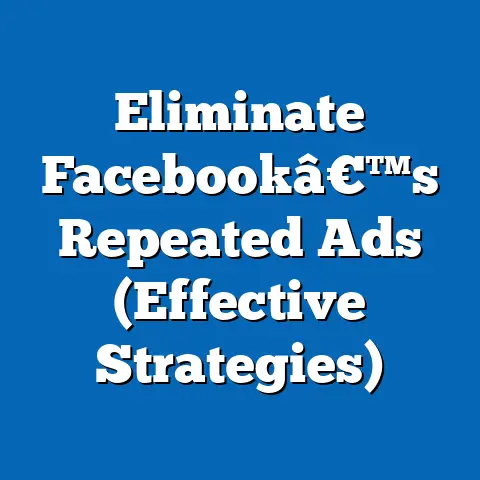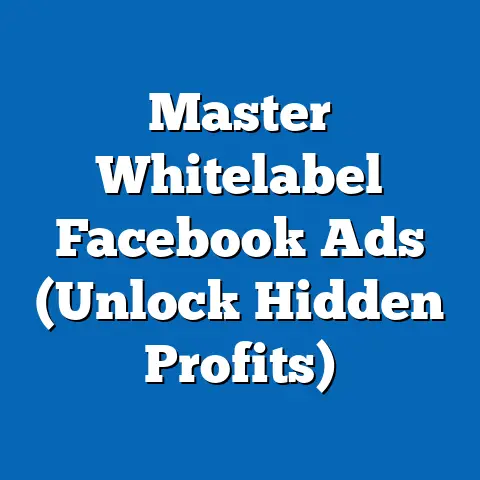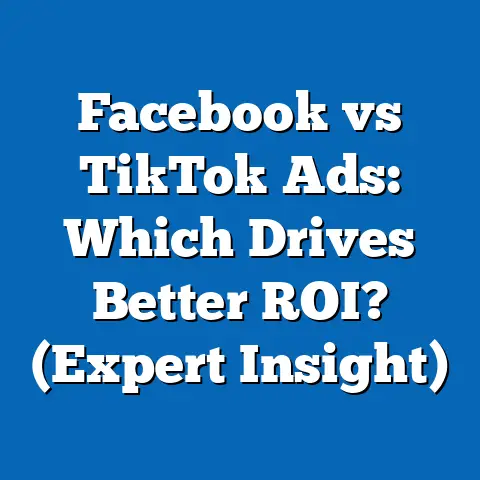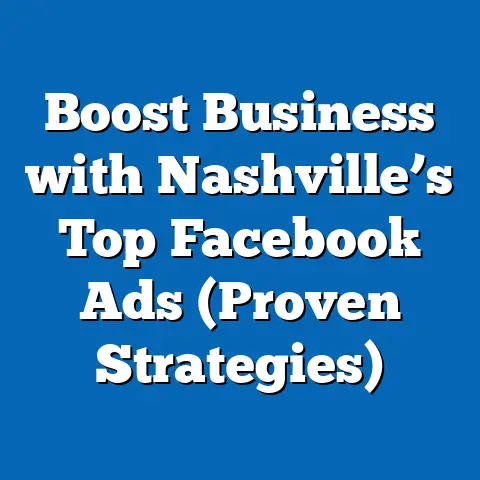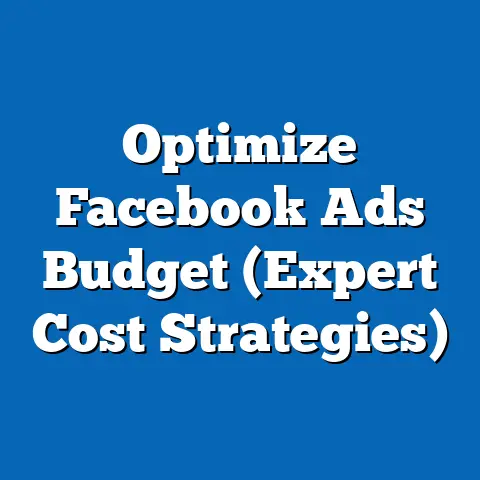Boost Engagement with Facebook Call Ads (Conversion Secrets)
Imagine this: you’re sipping coffee at your favorite café, laptop open, and you’re watching your Facebook Ads dashboard light up. Notifications are popping like firecrackers, and your phone is buzzing non-stop with calls from potential customers. They’re eager to connect, ask questions, and, most importantly, buy what you’re selling. This isn’t a pipe dream; it’s the power of Facebook Call Ads when implemented strategically. I’ve seen firsthand how these ads can transform a business, and in this guide, I’m going to share the secrets to unlocking their full potential.
1. Understanding Facebook Call Ads
Facebook Call Ads are a unique ad format specifically designed to encourage immediate phone calls from potential customers. Unlike traditional ads that drive traffic to a website or landing page, Call Ads feature a prominent “Call Now” button that allows users to connect directly with your business with a single tap.
How do they differ from traditional ads? Traditional Facebook ads focus on generating website clicks, leads through forms, or app installs. Call Ads, on the other hand, prioritize direct phone conversations. This difference in objective significantly impacts the ad creative, targeting, and overall campaign strategy.
Why is direct communication important in the digital age? In our increasingly digital world, a human touch can make all the difference. Customers often crave personalized interactions, especially when making important purchasing decisions. A phone call provides an opportunity to answer questions, build trust, and address concerns in real-time, leading to higher conversion rates. I’ve noticed that when customers feel heard and understood, they are far more likely to become loyal advocates for your brand.
The rise of mobile usage and its impact on advertising strategies: Mobile devices are now the primary way people access the internet. Facebook Call Ads capitalize on this trend by making it incredibly easy for mobile users to connect with businesses directly from their smartphones. This convenience is a game-changer, making Call Ads a highly effective tool for reaching on-the-go consumers.
Key Takeaway: Facebook Call Ads are a mobile-first ad format designed to drive immediate phone calls, offering a direct and personalized way to connect with potential customers.
2. The Psychology of Engagement
Engagement in digital marketing is more than just likes and shares; it’s about creating meaningful interactions that resonate with your audience.
What is engagement in digital marketing? Engagement encompasses all the ways customers interact with your brand online, including likes, comments, shares, clicks, and, most importantly, conversations. It’s a measure of how invested your audience is in your brand and your message.
Why are calls a vital component in creating a personal connection? While digital interactions are valuable, a phone call offers a level of personalization that’s hard to replicate online. It allows you to build rapport, understand customer needs, and provide tailored solutions. This personal connection fosters trust and loyalty, which are crucial for long-term business success. I’ve personally found that a quick phone call can often resolve issues and build relationships far more effectively than a lengthy email exchange.
How Call Ads tap into consumer psychology for higher conversion rates: Call Ads leverage several psychological principles. The immediacy of the “Call Now” button appeals to consumers who want instant gratification. The opportunity to speak directly with a representative reduces perceived risk and builds confidence. Furthermore, the personalized interaction creates a sense of value and importance, making customers more likely to convert.
Key Takeaway: Calls are a powerful tool for creating personal connections, building trust, and leveraging psychological principles to drive higher conversion rates.
3. Setting Up Your Facebook Call Ads Campaign
Creating an effective Facebook Call Ads campaign requires careful planning and execution. Here’s a step-by-step guide to get you started:
Step 1: Choosing the Right Objective
When creating your campaign in Facebook Ads Manager, select the “Lead Generation” objective. While it might seem counterintuitive since you’re aiming for calls, this objective allows you to optimize for leads who are most likely to call your business. Facebook’s algorithm will then prioritize showing your ad to users who have a history of making phone calls from ads.
Step 2: Defining Your Target Audience
Facebook’s advanced targeting features are a powerful tool for reaching the right audience. Consider these targeting options:
- Demographics: Target users based on age, gender, location, education, and other demographic factors.
- Interests: Reach users who have expressed interest in specific topics, hobbies, or brands related to your business.
- Behaviors: Target users based on their online behavior, such as purchase history, device usage, and travel habits.
- Custom Audiences: Upload your existing customer list to create a custom audience of people who already know and trust your brand.
- Lookalike Audiences: Expand your reach by creating a lookalike audience of people who share similar characteristics with your existing customers.
Example: If you’re a local plumbing company, you might target homeowners within a specific geographic area who have expressed interest in home improvement and have recently purchased plumbing supplies online.
Step 3: Crafting Compelling Ad Copy
Your ad copy is crucial for grabbing attention and encouraging users to call. Here are some tips:
- Highlight the benefits of calling: Clearly state what users will gain by calling your business. Will they receive a free consultation? A special discount? Expert advice?
- Create a sense of urgency: Encourage immediate action by using phrases like “Call now for a limited-time offer” or “Don’t miss out!”
- Use strong action verbs: Start your call to action with verbs like “Call,” “Speak,” or “Connect.”
- Keep it concise: Get straight to the point and avoid jargon or technical terms.
- Include your phone number: Although the “Call Now” button is prominent, it’s still a good idea to include your phone number in the ad copy for added clarity.
Example: “Need a reliable plumber fast? Call now for a free quote and same-day service! [Your Phone Number]”
Key Takeaway: Setting up a successful Call Ads campaign involves choosing the right objective, defining your target audience, and crafting compelling ad copy that encourages users to call.
4. Optimizing Call Ads for Maximum Impact
Once your campaign is up and running, it’s essential to continuously optimize it for maximum impact.
The Importance of A/B Testing
A/B testing involves creating multiple versions of your ad with slight variations and testing them against each other to see which performs best. Test different elements, such as:
- Ad copy: Try different headlines, descriptions, and calls to action.
- Visuals: Experiment with different images and videos.
- Targeting: Test different audience segments to see which responds best to your ads.
- Placement: See if your ads perform better on Facebook, Instagram, or the Audience Network.
Example: You might test two versions of your ad with different headlines: “Call Now for a Free Consultation” versus “Speak with an Expert Today!”
Analyzing Call Ads Metrics
Facebook provides valuable metrics for tracking the performance of your Call Ads:
- Impressions: The number of times your ad was shown.
- Reach: The number of unique people who saw your ad.
- Clicks (Link Clicks): The number of times people clicked on your ad.
- Call Button Clicks: The number of times people clicked the “Call Now” button. This is your primary metric for Call Ads.
- Cost Per Call (CPC): The average cost you paid for each call.
- Call Duration: The average length of calls generated by your ads.
- Conversion Rate: The percentage of calls that resulted in a desired action, such as a sale or appointment booking. (This requires tracking conversions after the call, which I’ll discuss later)
Tips for Optimizing Your Landing Page (for Users Who Call)
While Call Ads bypass the traditional landing page, it’s crucial to optimize the experience for users who call. This includes:
- Ensuring prompt and professional phone answering: Train your staff to answer calls quickly and professionally, providing helpful and informative responses.
- Tracking call conversions: Implement a system for tracking which calls originated from your Facebook Ads campaign and whether they resulted in a sale or other desired action. This could involve asking callers how they heard about your business or using call tracking software.
- Following up with callers: After the call, follow up with potential customers to answer any remaining questions and encourage them to take the next step.
Key Takeaway: Optimizing Call Ads requires continuous A/B testing, careful analysis of key metrics, and a focus on providing a positive experience for users who call.
5. Crafting an Irresistible Call to Action (CTA)
Your call to action (CTA) is the final push that motivates users to pick up the phone and call your business.
Elements of a High-Converting CTA
- Clarity: Your CTA should be clear and easy to understand. Tell users exactly what you want them to do.
- Specificity: Be specific about the benefits of calling. What will users gain?
- Action-oriented: Use strong action verbs that encourage immediate action.
- Urgency: Create a sense of urgency to motivate users to call now.
- Value Proposition: Highlight the value that users will receive by calling.
Effective CTA Examples for Different Industries
- Service-Based Businesses (e.g., Plumbers, Electricians): “Call now for a free quote and same-day service!”
- E-commerce Businesses (e.g., Online Retailers): “Call now to speak with a product expert and get personalized recommendations!”
- Healthcare Providers (e.g., Doctors, Dentists): “Call now to schedule your appointment and get a free consultation!”
- Financial Services (e.g., Insurance Agents, Financial Advisors): “Call now to review your policy and see if you’re getting the best rates!”
Enhancing CTAs with Urgency and Value Propositions
- Urgency: Use phrases like “Limited-time offer,” “Call before it’s too late,” or “While supplies last.”
- Value Proposition: Highlight the unique benefits of your business, such as “Expert advice,” “Personalized service,” or “Guaranteed satisfaction.”
Key Takeaway: A high-converting CTA should be clear, specific, action-oriented, and include a sense of urgency and a strong value proposition.
6. Integrating Call Ads with Other Marketing Strategies
Facebook Call Ads shouldn’t exist in isolation. They should be integrated with your other marketing strategies for a cohesive and effective approach.
Pairing Call Ads with Other Ad Formats
- Image Ads: Use visually appealing image ads to generate awareness and interest, then use Call Ads to capture leads who are ready to take action.
- Video Ads: Create engaging video ads that showcase your products or services, then use Call Ads to encourage viewers to learn more.
- Lead Generation Ads: Use Lead Generation Ads to collect contact information from users who aren’t ready to call, then use Call Ads to follow up with those leads.
Cross-Channel Marketing and Customer Journey Mapping
Cross-channel marketing involves coordinating your marketing efforts across multiple channels, such as Facebook, email, and your website. Customer journey mapping involves understanding the steps customers take when interacting with your brand. By mapping the customer journey, you can identify opportunities to use Call Ads to guide customers towards a purchase.
Retargeting Users Who Engaged with Call Ads
Retargeting involves showing ads to users who have previously interacted with your business. You can retarget users who clicked on your Call Ads but didn’t make a purchase, encouraging them to call again or visit your website.
Key Takeaway: Integrating Call Ads with other marketing strategies, including other ad formats, cross-channel marketing, and retargeting, can significantly amplify your results.
7. Case Studies: Success Stories with Facebook Call Ads
Let’s look at some real-world examples of businesses that have successfully used Facebook Call Ads:
Case Study 1: Local HVAC Company
- Strategy: Targeted homeowners within a 25-mile radius who were interested in home improvement and energy efficiency. Used ad copy that highlighted the benefits of a free HVAC inspection and offered a special discount for new customers.
- Results: Increased call volume by 40% and generated a significant number of new customers.
- Lesson Learned: Hyper-local targeting and a compelling offer can drive significant results for service-based businesses.
Case Study 2: Online Retailer
- Strategy: Used Call Ads to provide personalized product recommendations and answer customer questions. Targeted users who had previously visited their website but hadn’t made a purchase.
- Results: Increased sales by 25% and improved customer satisfaction.
- Lesson Learned: Providing personalized support and addressing customer concerns over the phone can significantly boost sales for e-commerce businesses.
Case Study 3: Medical Clinic
- Strategy: Used Call Ads to schedule appointments and provide information about their services. Targeted users who were searching for specific medical conditions or treatments.
- Results: Increased appointment bookings by 30% and improved patient acquisition.
- Lesson Learned: Call Ads can be a highly effective tool for healthcare providers to attract new patients and schedule appointments.
Key Takeaway: These case studies demonstrate the potential of Facebook Call Ads to drive significant results for businesses across various industries. The key is to understand your target audience, craft compelling ad copy, and optimize your campaign for maximum impact.
8. Future Trends in Facebook Call Ads and Digital Marketing
The digital marketing landscape is constantly evolving, and Facebook Call Ads are likely to adapt to new consumer behaviors and technological advancements.
The Evolving Landscape of Digital Marketing and Voice Technology
Voice search is becoming increasingly popular, and voice assistants like Siri and Alexa are becoming more prevalent. This trend suggests that voice-activated Call Ads could become a future feature on Facebook.
How Facebook Call Ads Might Adapt to New Consumer Behaviors
As consumers become more accustomed to personalized experiences, Facebook Call Ads may incorporate more advanced targeting and personalization features. This could include using AI to analyze call transcripts and provide tailored recommendations.
Staying Ahead of the Curve by Embracing Innovative Ad Formats
To stay ahead of the curve, it’s essential to experiment with new ad formats and technologies. This includes exploring augmented reality (AR) ads, virtual reality (VR) ads, and other immersive experiences.
Key Takeaway: The future of Facebook Call Ads is likely to be shaped by voice technology, personalized experiences, and innovative ad formats. Staying ahead of the curve requires continuous learning and experimentation.
Conclusion: Bringing It All Together
Facebook Call Ads are a powerful tool for boosting engagement and conversions. By understanding the psychology of engagement, setting up your campaign strategically, optimizing for maximum impact, crafting irresistible calls to action, integrating Call Ads with other marketing strategies, and learning from successful case studies, you can unlock the full potential of this ad format.
I encourage you to take action and integrate Call Ads into your marketing strategies. Envision the success that awaits you as you connect authentically with your audience, drive more calls, and generate more sales. The possibilities are endless, and the time to start is now. Pick up that virtual phone and start dialing your way to success with Facebook Call Ads!

